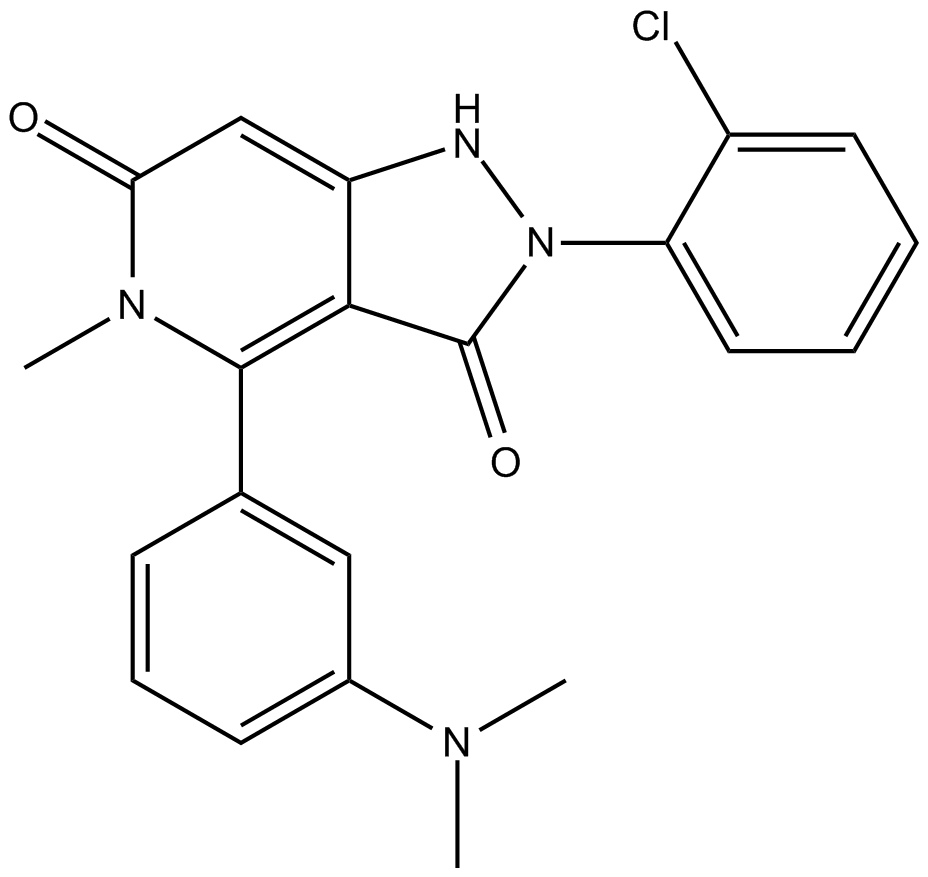GKT137831 |
| Catalog No.GC11882 |
GKT137831(GKT137831)은 Kis가 각각 140 및 110 nM인 선택적 NADPH 산화효소(NOX1/4) 억제제입니다.
Products are for research use only. Not for human use. We do not sell to patients.

Cas No.: 1218942-37-0
Sample solution is provided at 25 µL, 10mM.
Ki: 140 nM and 110 nM
GKT137831 is a specific dual NADPH oxidase Nox1/Nox4 inhibitor, respectively[1].
Both Nox1 and Nox4 expressed in vascular smooth muscle cells (VSMCs) are targeted to discreet intracellular locations, are differentially regulated in response to growth factors and vascular injury, and are activated by distinct mechanis
In vitro: GKT137831 lowers hypoxia-induced H(2)O(2) release, cell proliferation, and TGF-β1 expression and attenuated reductions in PPARγ in HPAECs and HPASMCs. [2] GKT137831 also is a blockade of oxidative stress in response to hyperglycemia in human aortic endothelial cells. [3]
In vivo: In WT and SOD1mut mice, GKT137831 (60 mg/kg i.g.) prevents liver fibrosis and downregulates markers of oxidative stress, inflammation, and fibrosis. [1] In mouse model of chronic hypoxia exposure, GKT137831 (60 mg/kg/d p.o.) attenuates lung PPARγ and TGF-β1 expression of chronic hypoxia–induced right ventricular hypertrophy, vascular remodeling, lung cell proliferation, and hypoxic alterations [2]. GKT137831 (60 mg/kg/d p.o.) also attenuates diabetes mellitus-stimulated atherosclerosis in diabetic apolipoprotein E-deficient mice. [3] Furtermore, GKT137831 prevents the increase of oxidative stress in angII-infused c-hNox4Tg mice, abolishes Akt-mTOR and NF-κB signaling pathway and lowers cardiac remodeling. [4]
Clinical trial: Clinical study has been conducted.
References:
[1] Aoyama T, Paik YH, Watanabe S, Laleu B, Gaggini F, Fioraso-Cartier L, Molango S, Heitz F, Merlot C, Szyndralewiez C, Page P, Brenner DA. Nicotinamide adenine dinucleotide phosphate oxidase in experimental liver fibrosis: GKT137831 as a novel potential therapeutic agent. Hepatology. 2012 Dec;56(6):2316-27.
[2] Green DE, Murphy TC, Kang BY, Kleinhenz JM, Szyndralewiez C, Page P, Sutliff RL, Hart CM. Circulation. The Nox4 inhibitor GKT137831 attenuates hypoxia-induced pulmonary vascular cell proliferation. Am J Respir Cell Mol Biol. 2012 Nov;47(5):718-26.
[3] Gray SP, Di Marco E, Okabe J, Szyndralewiez C, Heitz F, Montezano AC, de Haan JB, Koulis C, El-Osta A, Andrews KL, Chin-Dusting JP, Touyz RM, Wingler K, Cooper ME, Schmidt HH, Jandeleit-Dahm KA. NADPH oxidase 1 plays a key role in diabetes mellitus-accelerated atherosclerosis. Circulation. 2013 May 7;127(18):1888-902.
[4] Zhao QD, Viswanadhapalli S2, Williams P2, Shi Q2, Tan C2, Yi X2, Bhandari B2, Abboud HE2. NADPH oxidase 4 induces cardiac fibrosis and hypertrophy through activating Akt/mTOR and NFκB signaling pathways. Circulation. 2015 Feb 17;131(7):643-55.
Average Rating: 5 (Based on Reviews and 7 reference(s) in Google Scholar.)
GLPBIO products are for RESEARCH USE ONLY. Please make sure your review or question is research based.
Required fields are marked with *




















